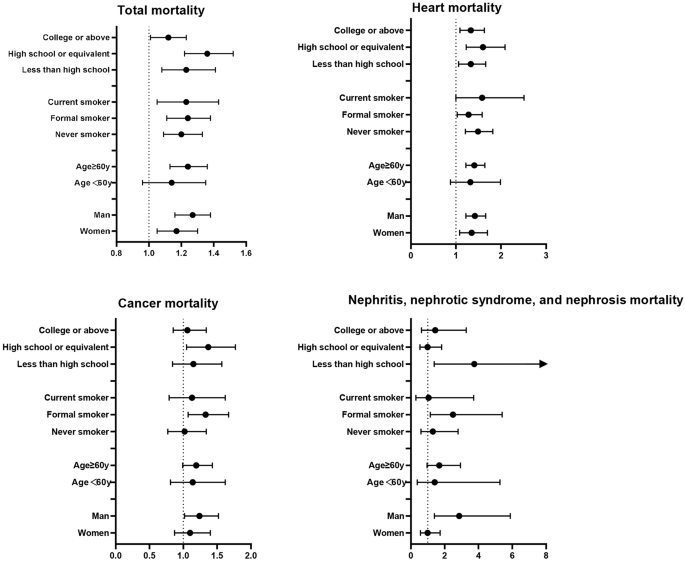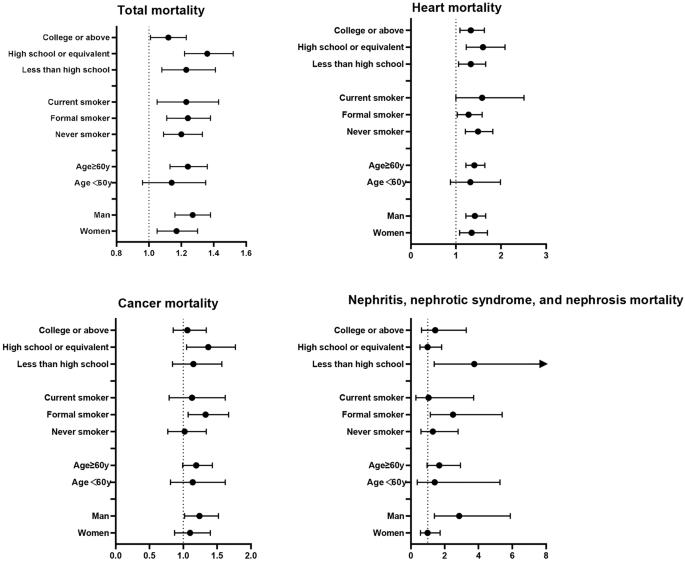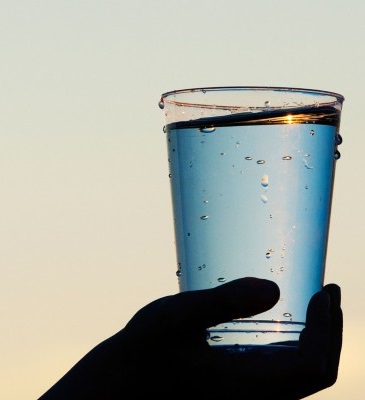家用水处理设备的使用与死亡率的关系
IF 10.4
1区 工程技术
Q1 ENGINEERING, CHEMICAL
引用次数: 0
摘要
本研究旨在调查家用水处理设备(UHWTD)的使用与总死亡率和特定病因死亡率之间的关系,以解决该领域缺乏全面前瞻性研究的问题。该研究是一项基于人群的前瞻性队列研究,使用的数据来自美国国家健康与营养调查(NHANES,1999-2010 年)。在30,322名参与研究的人员中,无超高血压人群(无超高血压人群)与超高血压人群相比更年轻,但基线健康状况更差。在平均 14.3 年的随访期间,有 6811 名参与者死亡。在对年龄、性别和其他协变量进行调整后,无 UHWTD 组的总体死亡风险明显更高(调整后危险比 [aHR]:1.221,95% 置信区间 [CI]:1.147-1.300):与超高血压相比,无超高血压与较高的总体(调整危险比 [1.221],95% 置信区间 [CI]:1.147-1.300)、心脏(aHR:1.405,95% CI:1.241-1.589)、癌症(aHR:1.176,95% CI:1.003-1.379)、阿尔茨海默病(aHR:1.404,95% CI:1.027-1.919)和肾病(aHR:1.613,95% CI:1.026-2.537)死亡率风险明显相关。此外,在对水源进行进一步调整后,这些主要的关联几乎仍然存在。此外,我们还观察到,与无超高压水处理相比,使用家用水处理设备时,自来水中溴甲烷、氯仿、溴二氯甲烷和二溴氯甲烷的检出率较低。在这个前瞻性队列中,使用家用水处理设备与总体死亡率、心脏病死亡率、癌症死亡率、老年痴呆症死亡率和肾病死亡率的适度降低有关。这些研究结果表明,使用家用水处理设备有可能影响健康结果并延长预期寿命。本文章由计算机程序翻译,如有差异,请以英文原文为准。


Associations of the utilization of household water treatment devices with mortality
This study aimed to investigate the relationship between the utilization of household water treatment devices (UHWTD) and both overall and cause-specific mortality, addressing the lack of comprehensive prospective research in this area. The study was a population-based prospective cohort study using data from the US National Health and Nutrition Examination Survey (NHANES 1999–2010). Among the 30,322 participants included in the study, the group without UHWTD (No UHWTD) was younger but reported worse baseline health compared to the UHWTD group. During an average follow-up period of 14.3 years, 6811 participants died. After adjusting for age, sex, and other covariates, No UHWTD was significantly associated with a higher risk of overall (adjusted hazard ratio [aHR]: 1.221, 95% Confidence Interval [CI]: 1.147–1.300), heart (aHR: 1.405, 95% CI: 1.241–1.589), cancer (aHR: 1.176, 95% CI: 1.003–1.379), Alzheimer’s disease (aHR: 1.404, 95% CI: 1.027–1.919), and nephrosis (aHR: 1.613, 95% CI: 1.026–2.537) mortality compared to UHWTD. Moreover, those main association almost remained after further adjustment for water source. Additionally, we observed a lower detection rate of bromoform, chloroform, bromodichloromethane, and dibromochloromethane in tap water when household water treatment devices was used compared to No UHWTD. The utilization of household water treatment devices in this prospective cohort was associated with modest reductions in the risk of overall, heart, cancer, Alzheimer’s disease, and nephrosis mortality. These findings suggest that the use of household water treatment devices may have the potential to influence health outcomes and extend life expectancy.
求助全文
通过发布文献求助,成功后即可免费获取论文全文。
去求助
来源期刊

npj Clean Water
Environmental Science-Water Science and Technology
CiteScore
15.30
自引率
2.60%
发文量
61
审稿时长
5 weeks
期刊介绍:
npj Clean Water publishes high-quality papers that report cutting-edge science, technology, applications, policies, and societal issues contributing to a more sustainable supply of clean water. The journal's publications may also support and accelerate the achievement of Sustainable Development Goal 6, which focuses on clean water and sanitation.
 求助内容:
求助内容: 应助结果提醒方式:
应助结果提醒方式:


